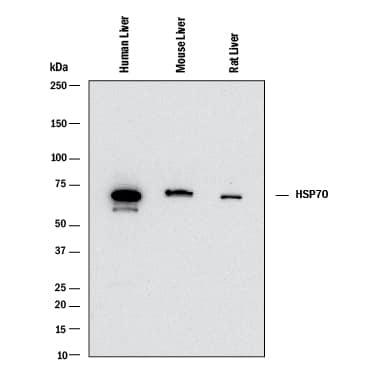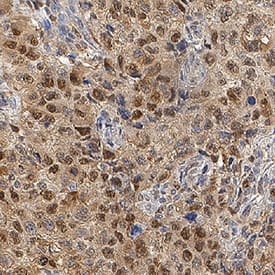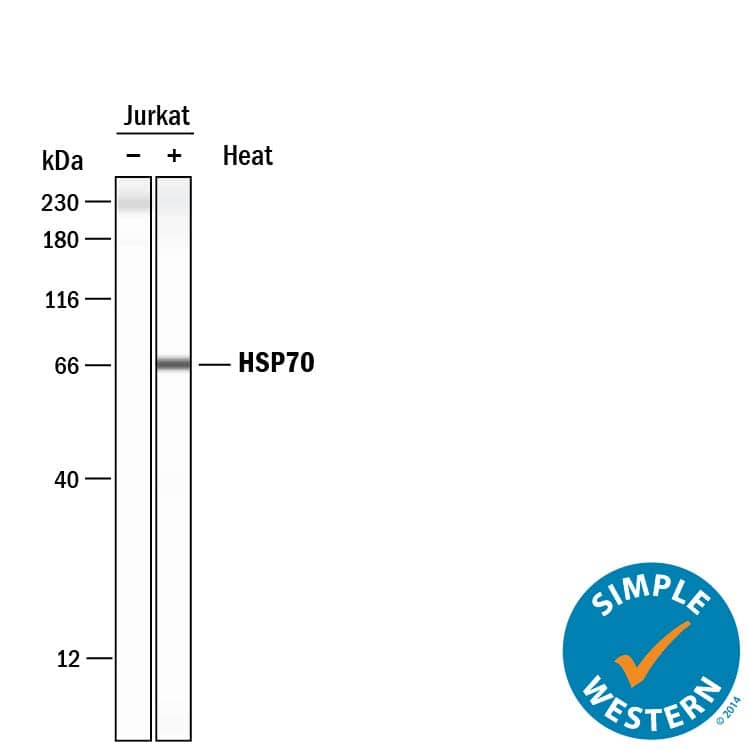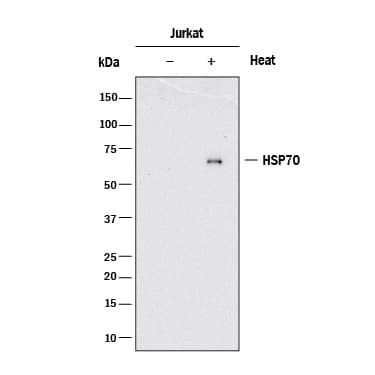Human/Mouse/Rat HSP70/HSPA1A Antibody
R&D Systems, part of Bio-Techne | Catalog # MAB16631

Key Product Details
Validated by
Species Reactivity
Applications
Label
Antibody Source
Product Specifications
Immunogen
Met1-Asp641
Accession # P0DMV8 and P0DMN9
Specificity
Clonality
Host
Isotype
Scientific Data Images for Human/Mouse/Rat HSP70/HSPA1A Antibody
Detection of Human HSP70/HSPA1A by Western Blot.
Western blot shows lysates of Jurkat human acute T cell leukemia cell line untreated (-) or treated (+) with 42° C heat shock for 30 minutes and allowed to recover for 3 hours. PVDF membrane was probed with 2 µg/mL of Mouse Anti-Human/Mouse/Rat HSP70/HSPA1A Monoclonal Antibody (Catalog # MAB16631) followed by HRP-conjugated Anti-Mouse IgG Secondary Antibody (Catalog # HAF018). A specific band was detected for HSP70/HSPA1A at approximately 70 kDa (as indicated). This experiment was conducted under reducing conditions and using Immunoblot Buffer Group 1.Detection of Human. Mouse, and Rat HSP70/HSPA1A by Western Blot.
Western blot shows lysates of human liver tissue, mouse liver tissue, and rat liver tissue. PVDF membrane was probed with 2 µg/mL of Mouse Anti-Human/Mouse/Rat HSP70/HSPA1A Monoclonal Antibody (Catalog # MAB16631) followed by HRP-conjugated Anti-Mouse IgG Secondary Antibody (Catalog # HAF018). A specific band was detected for HSP70/HSPA1A at approximately 70 kDa (as indicated). This experiment was conducted under reducing conditions and using Immunoblot Buffer Group 1.HSP70/HSPA1A in Jurkat Human Cell Line.
HSP70/HSPA1A was detected in immersion fixed Jurkat human acute T cell leukemia cell line using Mouse Anti-Human/Mouse/Rat HSP70/HSPA1A Monoclonal Antibody (Catalog # MAB16631) at 8 µg/mL for 3 hours at room temperature. Cells were stained using the NorthernLights™ 557-conjugated Anti-Mouse IgG Secondary Antibody (red; Catalog # NL007) and counterstained with DAPI (blue). Specific staining was localized to nuclei. View our protocol for Fluorescent ICC Staining of Non-adherent Cells.Applications for Human/Mouse/Rat HSP70/HSPA1A Antibody
Immunocytochemistry
Sample: Immersion fixed Jurkat human acute T cell leukemia cell line
Immunohistochemistry
Sample: Immersion fixed paraffin-embedded sections of human kidney cancer tissue
Simple Western
Sample: Jurkat human acute T cell leukemia cell line treated by heat shock
Western Blot
Sample: Jurkat human acute T cell leukemia cell line treated by heat shock, human liver tissue, mouse liver tissue, and rat liver tissue
Formulation, Preparation, and Storage
Purification
Reconstitution
Formulation
Shipping
Stability & Storage
- 12 months from date of receipt, -20 to -70 °C as supplied.
- 1 month, 2 to 8 °C under sterile conditions after reconstitution.
- 6 months, -20 to -70 °C under sterile conditions after reconstitution.
Background: HSP70/HSPA1A
Heat shock proteins (HSPs) are a family of highly conserved stress response proteins. Heat shock proteins function primarily as molecular chaperones by facilitating the folding of other cellular proteins, preventing protein aggregation or targeting improperly folded proteins to specific degradative pathways. HSPs are typically expressed at low levels under normal physiological conditions but are dramatically up‑regulated in response to cellular stress. HSP70 is a 72 kDa member of the heat shock protein 70 family of proteins. HSP70, also known as HSPA1A, HSP70-1, and HSP72 is a 641 amino acid (aa) heat shock protein. Over aa 1-641, human HSP70 shares 95% and 97% aa identity to mouse and rat HSP70.
Long Name
Alternate Names
Gene Symbol
UniProt
Additional HSP70/HSPA1A Products
Product Documents for Human/Mouse/Rat HSP70/HSPA1A Antibody
Product Specific Notices for Human/Mouse/Rat HSP70/HSPA1A Antibody
For research use only




